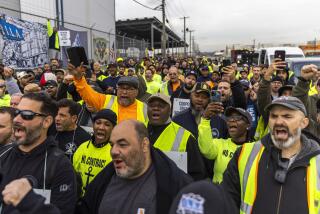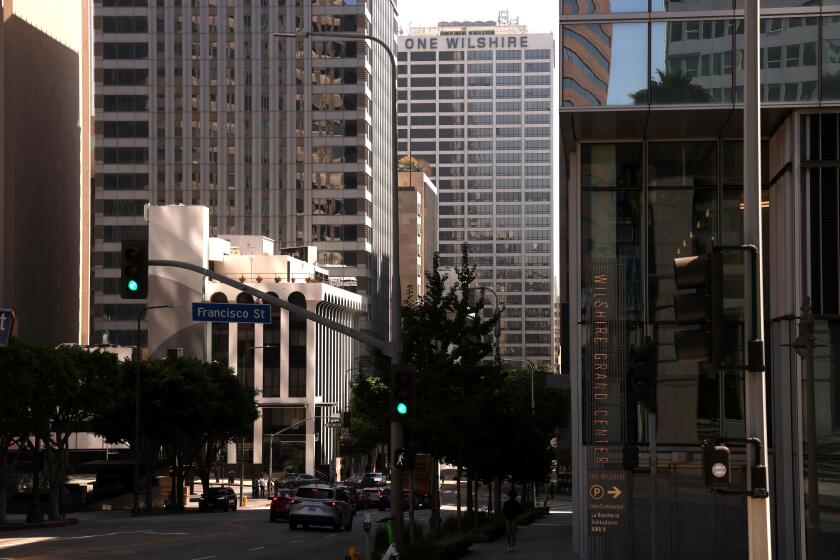Troop Carrier Had Big Financial Losses : But U.S. Regulators Say an Airline Need Not Be Solvent to Be Safe
Long before one of its DC-8s slammed into a Newfoundland hillside this month, killing 256 people, Miami-based Arrow Air Inc. had kept its planes aloft with some seat-of-the-pants financing. Arrow’s stock value was a minus $14.5 million; until May, losses averaged $600,000 a month. At 1984’s end, Arrow owed $6 million to one firm that services its jets.
Such figures might keep an airline passenger awake nights. Not so the federal Transportation Department, watchdog of airline finances since the Civil Aeronautics Board went out of business a year ago.
The department’s Federal Aviation Administration, the primary airline safety agency, says it was not concerned this year about the potential effect of steady losses on Arrow’s operations. Nor were the department’s non-safety experts--mostly ex-CAB officials--who keep track of the industry’s fiscal fitness.
“I do know they were in a weak financial position,” said Patricia T. Szrom, who oversees financial reviews of airlines, “but unfortunately, we have a very small staff, and there are a lot of carriers not in the best of financial condition.”
Staff Has Double Duty
She is right on both counts. The money problems dogging Arrow have plagued dozens of the 300 other air carriers, from Eastern Airlines and Pan American World Airways to more anonymous firms--including several “supplemental” airlines which, like Arrow, hold Pentagon contracts to ferry military personnel. Szrom’s 12-person office is supposed to check the continuing financial fitness of all 300, as well as process the 80 or so applications for new flying rights that are filed annually.
Some now say that the task merits more attention. While there is no evidence that money woes figured in the Newfoundland disaster--some FAA officials praise Arrow’s safety-related spending--those experts argue that fiscal “corner-cutting” is shaving safety margins, especially in the flock of less-cushioned, smaller carriers that have begun flying in recent years.
A few worry that the government may be letting cash-strapped airlines fly on their honor, even when financial distress is painfully apparent.
“As far as new entrant carriers--how good or bad--it’s difficult to say,” said Frank Taylor, a retired federal aviation safety expert who now is a private consultant. “The FAA is just not able to ride herd on a lot of these carriers. They don’t have the manpower to do it.”
Fear of Shortcuts
“If a carrier really wants to be economical by making shortcuts or deferring maintenance,” said Jerard Bruggink, a retired air-crash investigator and consultant, “he can do it--and they do. So you cannot blame the FAA. There’s no carrier in business for charitable purposes. They’re in it to make money.”
Federal officials call such fears overstated and point out--rightly--that nearly bankrupt carriers of all sizes have flown with superb safety records. An airline’s bottom line is irrelevant, they say, as long as regulators ensure that enough money is set aside for safety-related expenses.
“We have not found an operationally useful correlation between the balance sheet and the quality of maintenance done by an airline,” said Anthony J. Broderick, the FAA’s associate administrator for aviation standards.
Stephen G. Smith, once a fiscal analyst at the old CAB and now a Washington aviation consultant, agrees. “It’s extremely difficult to derive a connection between fiscal stability and safety,” he said. “Some people are extremely responsible and would rather shut their doors than lose an airplane.”
Yet Smith and others still find such a connection difficult to dismiss. If money has never caused an accident, they suggest, the chase after fast bucks--the unchecked growth of competing airlines, the drive to cut costs by hiring less-experienced workers or deferring maintenance--may well be a factor.
Sees Lack of Discipline
“Sure, Eastern has lost money, but the people suffering are the creditors who aren’t getting paid,” said one longtime aviation safety official who once supervised military charter contracts.
“With a single operator, he’s losing his own money. There’s a greater chance of taking shortcuts--letting squawks go unattended, and so on. Charter operators, in my judgment, are not those who come from that strong discipline generated by the big companies.”
The last major charter disaster--January’s Galaxy Airlines crash in Reno, which killed 70 gambling junketeers and crewmen--was blamed last month on crew error. Last July, however, a House Public Works subcommittee raked the Transportation Department for failure to probe allegations that Galaxy’s owner was in financial trouble.
In hearings of the Public Works oversight subcommittee, Szrom testified that she told FAA safety officials of “very great concern” about the fiscal practices of Galaxy’s owner before the carrier was granted an operating certificate in 1983. According to the hearing record, the line’s owner bought Galaxy’s operating rights from two license-holders in May, 1983, and won approval of the transfer later, despite evidence that a second charter service he owned had a legacy of unpaid bills.
Safe, Not Solvent
Transportation Department officials replied then that the law requires an airline to be safe, not solvent, and that Galaxy appeared safe to FAA officials up until the day its Lockheed Electra crashed. Broderick said this week that smaller airlines such as Galaxy actually are inspected more intensively than large ones, “because smaller airlines are less sophisticated.”
In the case of Arrow, Broderick noted, FAA officials were paying especially close attention because the carrier had been singled out in 1984 for lax management practices and inspected bolt by bolt. Broderick and others, rejecting published complaints of poor maintenance at the airline, say Arrow willingly improved its operations and they met FAA standards at the time of the Newfoundland disaster.
Transportation officials also note that the number of FAA safety inspectors is at a decade-high 674 and that Secretary Elizabeth Hanford Dole has set up a task force to coordinate FAA safety work and the financial-oversight duties of the old CAB.
In theory, the department’s safety and fiscal gears are supposed to mesh, with the fiscal experts warning the safety experts of financial danger signals and vice versa. But the degree to which that actually occurs is not entirely clear.
No Financial Standard
Department officials admit they have no written standards for determining when red ink becomes a danger signal worthy of special scrutiny. Several say privately that most financial reporting has been abolished during the Reagan Administration, so only bare-bones figures on airline operations are available to look at anyway.
What figures do exist make for sobering reading. A look at the 1984 and 1985 reports of six other supplemental airlines with Pentagon contracts disclosed that five had lost money in at least one of those years, with the total losses ranging as high as $6.4 million. One, like Arrow, had a net stock value that was negative.
A seventh non-military charter, picked at random from the Transportation Department’s bulging files, also reported a loss and a stock equity figure below zero.
More to Read
Inside the business of entertainment
The Wide Shot brings you news, analysis and insights on everything from streaming wars to production — and what it all means for the future.
You may occasionally receive promotional content from the Los Angeles Times.










